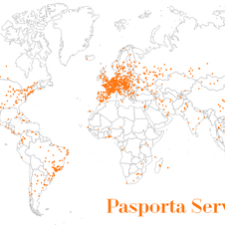Videogames are perhaps one of modern days’ biggest tech-recreational businesses. It is everywhere and exists in an incomprehensible myriad of forms – from the massive online multiplayer games, to puzzle/problem solving machines, to deeply immersive and impactful stories. It is this last part I want to focus on a bit, because compared to other forms of media – literature, movies, tv-series – videogames are made distinct by their core: that they are supposed to be played by someone; that they have a player. This makes them uniquely oriented towards interaction and thus invites the player to immerse themselves very deeply in the stories that a game is telling. And one of the tools that a game can utilize in its endeavor to tell a fantastical story, set in an imagined land far away, is to use language. Of course, the story will always use language, in that it is to some extent written, but I refer here specifically to the use of constructed or modified language to say something within the story; a watsonian look on language use, to borrow from literary terminology.

I want to introduce three games as examples, each using language in different ways as storytelling devices to drive immersion into their respective worlds: Final Fantasy X, Sundered and NieR.
Final Fantasy X
In this game, the player character gets flung across time to a seemingly other world. In this world, there is a group of people, the Al Bhed, who are characterized by their distinct green eye-color and their inclination towards machinery, contrary to using magic. More importantly, however, is that they are presented as speaking a different in-universe language, also called Al Bhed.

On the surface, this “language” is nothing but a mere cipher, substituting letters for each other. The interesting part is that the game features a good deal of voice-acting, and so this “language” is actually spoken by the actors in the game. So while this is a substitution cipher, there have still been made considerations towards phonotactics (the way a language combines sounds) and appears semi-systematized in its substitution. One of the clever tricks employed is substituting the letters of voiceless stops for their voiced equivalents and vice versa (ptk ↔ bdg). Likewise, vowels are only substituted with vowels, and fricatives, laterals, rhotics, and glides are more freely substituted with each other. This all, along with the actors’ performances of course, gives the impression of a real, or more natural language and upholds an illusion of a living, breathing world separate from the player characters.
Sundered
Sundered is a game about exploring ancient underground ruins, guided by a disembodied voice of a Trapezohedron. The game’s aesthetics are very influenced by lovecraftian horror, and as such, the creators have taken a more artistic approach to using language: the voice of the Trapezohedron speaks what the studio calls Eschaton, a language created by the studio’s writer, Kai Le Caroff. Compared to the Al Bhed language, this is more akin to that of a constructed language, or conlang. The sounds are primarily inspired by German and Old English, with some added sounds for flavor, and from these, words, sentences and dia-/monologue are built. Like with Final Fantasy X, Sundered features a voice actor, and as such the Eschaton language truly comes to life as a taunting, oppressive, and snarky monologuing towards the player. And since the player character is not voiced, the effect is that the Trapezohedron speaks directly to you, serving as a sort of welding-tool towards the player and the player character. This trailer features some spoken Eschaton, as example: Sundered – Embrace Trailer
NieR
The last example I want to dive into is that of the game NieR. It is set over 1000 years into the future after a cataclysmic event, and while the player character, their companions and almost every inhabitant speaks English (or Japanese, depending), the soundtrack is filled with what the creator, Emi Evans, refers to as Chaos Language. Evans is the lead singer and lyricist of the soundtrack, with Keiichi Okabe as composer, and her utility of synthesizing sounds from different languages – most notably English, Japanese, French, and Irish – evokes a sense of ancient language forms that are unintelligible to modern ears. The lyrics are not real language, insofar as it does not readily map onto any meaning and is not really translatable, but instead invokes emotional states to accompany the action or drama happening within the story. The closest comparable is listening to music in languages foreign to you; you do not necessarily understand any of the words, but you might still understand the underlying sentiments conveyed; you still feel the music. Chaos Language then serves a dual purpose of supporting the world-building of a long-lost world, detached from its own history, and as an emotional impetus, as it is featured almost entirely through song.
Summation
These three examples show the different and similar ways creators employ the use of language, not just as a tool for writing, but also as devices within the stories themselves to help guide the player towards deeper immersion. And it should remind us that language is both a toolset and artform at the same time.
J. Valentin Keller is a MA student of linguistics at Aarhus University and has a particular interest in the relationship between language, gender, identity and art.
Further reading
Thunder Lotus Games’ blog post on the creation of the Eschaton language:
https://thunderlotusgames.com/rlehshyshtag-lirl-ehmgvrlaekeh-creating-new-language-sundere
d/
Interview with Emi Evans about her creative process of the NieR soundtrack:
https://blog.playstation.com/2020/12/18/nier-replicant-singer-emi-evans-talks-music-chaos-lang
uage-and-more/
Listen to the NieR and NieR: Automata soundtracks, and if you’re so inclined, play the games
mentioned above and immerse







